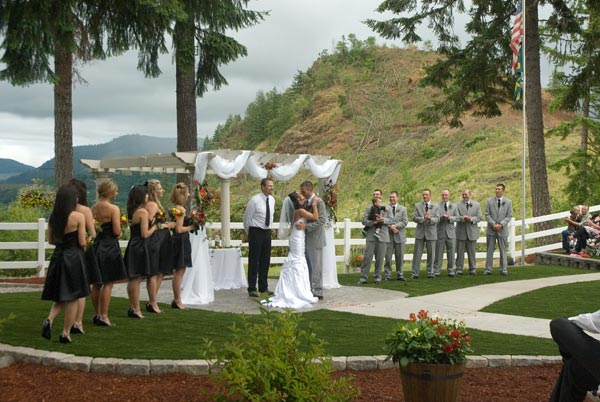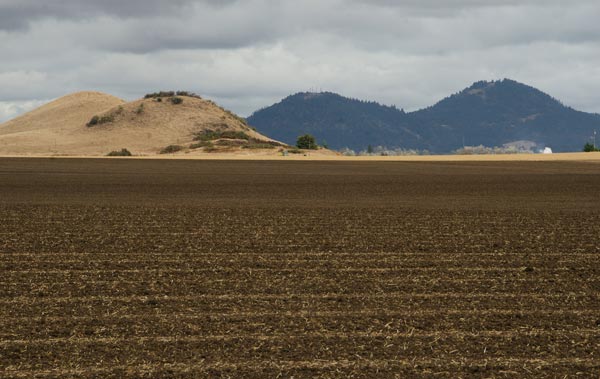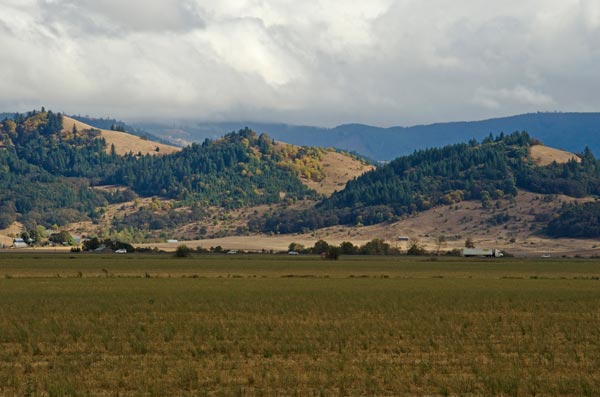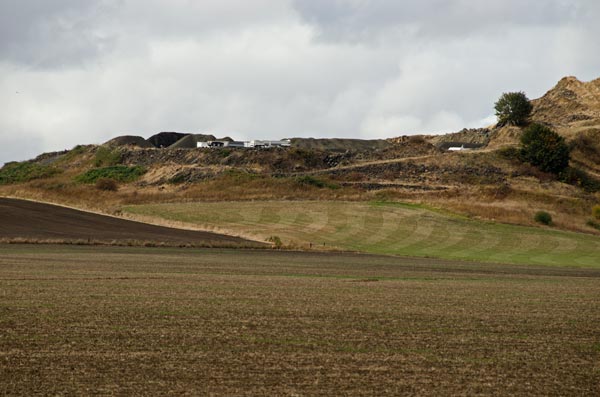“The mountains once were people, our grandfathers used to tell us,” begins a Warm Springs legend of how Eastern Oregon’s Black Butte came to be and how it came to provide the plants and animals used by the Native Americans. Mountains, buttes and knolls seem eternal as they stand sentinel over Oregon’s landscape, but as photographer John Bauguess watched miners dig away at Parvin Butte in the small community of Dexter, he began to wonder what other high places the Willamette Valley might be losing to development.
 |
| Near Parvin Butte, for thousands of years a Kalapuya winter village site near Dexter, Courtney Proden and Adam Winebrenner were married last summer. It was for a few hours quiet on this wedding day, without the noise of trucks and earthmovers. Since fall 2010 residents of Dexter and Lost Valley have endured the disruptive activity of developers Greg Demers and the McDougal brothers who plan to mine historic Parvin Butte, taking down most of it for its industrial rock. |
“What’s the future of these things and what’s their significance to the landscape?” Bauguess asks. He has begun to document these disappearing buttes — high places, some still untouched, some hacked away for their gravel and rock by local developers such as the McDougal brothers and Greg Demers, who have been controversially mining Parvin Butte, and others gouged at by international corporations such as Knife River, which is seeking to expand its mining at Springfield’s Quarry Butte.
Oregon’s geologic history of ancient seas, volcanic eruptions and long-ago floods left the Willamette Valley with aggregate rock, basalt and other stone that are now used in road building and construction. “You eliminate portions of the landscape in order to pave it over,” Bauguess says. Deep gravel pits along the Willamette put the river at risk, and floodplain gravel extraction turns farmland that could be used for local food production into still more mines. Buttes typically don’t have the kinds of soils or land useful for farming, but losing these high places not only destroys the landscape and the ecosystem it’s part of, it also means destroying history and a sense of place.
We’re drawn to these high places partly out of a sense of ritual and of spirituality; they have cultural significance, Bauguess says. His photos include a lighted cross in Coburg, a wedding at Parvin Butte and a butte in Jasper that local natural historian Bill Burwell says was probably a vision/naming quest site for the Kalapuya. Bauguess says that a conversation with Burwell about Parvin Butte and Burwell’s “feeling for the land and what happened here 12,000 years ago was a powerful influence as I looked at these places.” Burwell, like Bauguess, grew up in the area, exploring the buttes and the landscape.
People should know that these buttes were really very important to the people who lived here before, Burwell says. He says the Middle Fork of the Willamette River was such a heavily used area that just about every side stream had a winter village. Native Americans brought rocks up the butte in Jasper, creating cairns, often mistaken for graves, during their vision quests, he says.
Some buttes, such as Rattlesnake Butte outside Junction City, have been protected. That butte was restored to prairie habitat and oak savannah and handed over to the Confederated Tribes of Grand Ronde by state and federal agencies and The Nature Conservancy this fall. “That’s exactly what should be happening,” Burwell says. He says language studies and carbon dating show the Kalapuya have been in this area for more than 10,000 years, and relics of their winter village sites still remain, and remain unprotected. Parvin Butte is among the many high places in the valley that Burwell says may have been a significant cultural site to this area’s first peoples. Normally Burwell won’t talk about the locations of these sites, in order to protect them, but Parvin is already so compromised by the blasting and digging that he is fine with talking about its Native American past.
“I use the buttes as signposts as I drive,” Bauguess says. Driving south along I-5, the unique forms of the Coburg Hills tell Eugeneans they are getting close to home. Bauguess speculates the valley’s buttes were also points of reference to early peoples, as well as places to stand and look out across the valley, “almost like looking out to sea,” he says. “A lot of people who travel the valley recognize these unique features,” Bauguess says. “There’s an aesthetic thing about them that cannot be denied.”
 |
 |
 |
 |
|
Photos: Views of Bond Butte Rock Quarry, one of the oldest Willamette Valley gravel operations near Interstate-5, and a few unmarred buttes and knolls within 30 miles northeast of Eugene and Cox Butte west of Junction City.
|